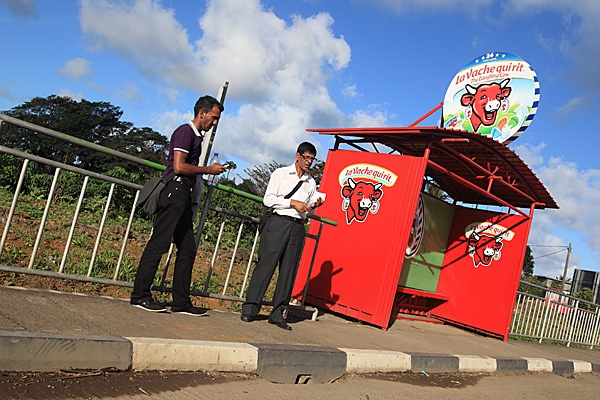Mauritius: Mauritius Transportation Profile
2013/08/18

There are currently no railways in Mauritius. There were before industrial railways,[1] but these have been abandoned.
A railway system existed from 1860s to the 1960s. Due to persistent unprofitability from 1948 to 1953, it was finally closed in 1964.
To cope with increasing road traffic congestion, a Light Rail Transit system has been proposed between Curepipe and Port Louis. As of 2011, it is still in the planning stages.
The proposed system would cover a distance of some 25 km, with some 13 stations, a lot of located in town centres along the route where existing transport terminals by presently exist. The end-to-end journey time would be approximately 32 minutes and carriages would be air-conditioned. Headways would vary by time of day, but are expected to be of the order of 5 minutes in peak periods. Access to stations would be by an integrated system of comfortable and reliable feeder buses.
At the beginning of 1860, the transport of passengers and goods was undertaken by about 2,000 horses, 4,000 donkeys and 4,500 carriages and carts.[3] With the advent of the railways, and later of motorized transport, animal based transport systems declined on the island.
In January 1901, the initial two seater car, imported by Goupille & Cie, was disembarked. In October of that same year, the Union Regnard sugar estate (Presently F.U.E.L) received the initial motorized truck of British origin, capable of transporting up to 5 tons.
In 1930, the island had 3016 vehicles: around 2,401 private cars, 300 taxis, 303 trucks, 92 buses and 220 motorcycles. In 1950, vehicles numbered in the 5,161 and went up to 13,291 in 1960 with the decline of the railways. In 1970, the number of vehicles nearly doubled, going to 25,389 motorised vehicles. This included 12,546 cars, 4,171 trucks, 722 buses and 5,383 motorcycles.
Public transport, in the form of buses, grew in line with the demographic and economic increase of the island. Thus, buses numbered 186 in 1950, 488 in 1960, 722 in 1970 and 1,490 in 1980.
At the beginning of 1860, the transport of passengers and goods was undertaken by about 2,000 horses, 4,000 donkeys and 4,500 carriages and carts.[3] With the advent of the railways, and later of motorized transport, animal based transport systems declined on the island.
National Transport Authority
The National Transport Authority (NTA) is a governmental department established under the Road Traffic Act in 1980 whose major responsibility is the regulation and control of road transport in Mauritius and Rodrigues. It falls under the responsibility of the Ministry of Public Infrastructure, Land Transport and Shipping.
The responsibility for the government of the NTA rests with the Road Transport Commissioner.
The NTA as well has a Board constituted under section 73 of the Road Traffic Act. The Board consists of a Chairman appointed by the Minister and 10 other members. It is responsible to hear and decide on
- applications for licenses for the transport of goods and passengers; and
- disciplinary proceedings instituted against transport operators, drivers and conductors of public service vehicles for offences committed under the Act.
The other responsibilities of this governmental department are:
- registration and transfer of ownership of motor vehicles;
- licensing of public service vehicles and goods vehicles inclunding petrol service stations;
- collection of road tax and other licence fees;
- examination of motor vehicles as to their road-worthiness;
- licensing of bus conductors;
- enforcement of road transport legislation and monitoring the level of service of public transport;
- enforcement of parking regulations;
- keeping statistics relating to motor vehicles; and
-
planning of new transport services.
Road network
For a small island of 1 865 km2, there are 2 066 km of roads in Mauritius, of which 48.5% are major roads, 28.7% are secondary roads, 3.6% are motorways and the remaining 19.2% are made up of other types of roads. The number of vehicles per km of road is at 177 as of 2009. The bus network is completely extensive and is organized around Port Louis. New air-conditioned buses have been introduced to link Port Louis with the major residential areas of the island.
Air transport

Road network

- Mauritius News
-
- AFGHANISTAN: UNWTO: International tourism – strongest half-year results since 2010
- BOTSWANA: Why governments need to support the financial sector to meet the unserved needs of smallholder farmers
- BOTSWANA: International Arrivals To Africa Reach More Than 18 Million In 2017
- BOTSWANA: Africa: USA-Africa - No Policy? Bad Policy? or Both?
- BOTSWANA: Africa: U.S. State Department To Get Experienced Diplomat in Key Africa Post
- BOTSWANA: Africa’s economic growth in 2016 was driven by East Africa
- Trending Articles
-
- CAMEROON: Cameroon: English-speaking Students Do Not Return to School
- CAMEROON: Cameroon: Giving Priority to Education
- RWANDA: Rwanda: RDB's Good Problem - More Gorillas, Less Habitat
- RWANDA: Women Make Up More Than Half of Rwanda's New Cabinet
- BOTSWANA: Africa: U.S. State Department To Get Experienced Diplomat in Key Africa Post
- UNITED STATES: Kenya Airways Gets Permit For Direct U.S. Flights






.gif?1356023993)

